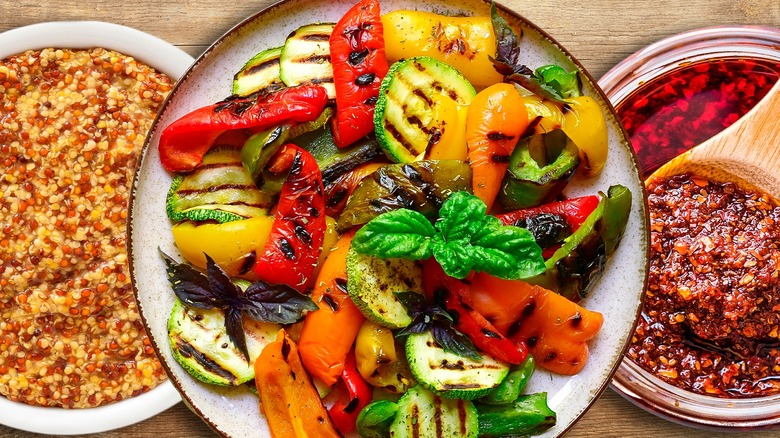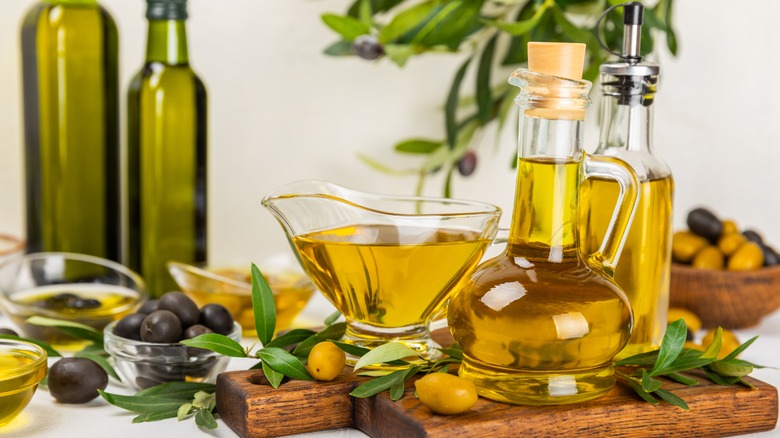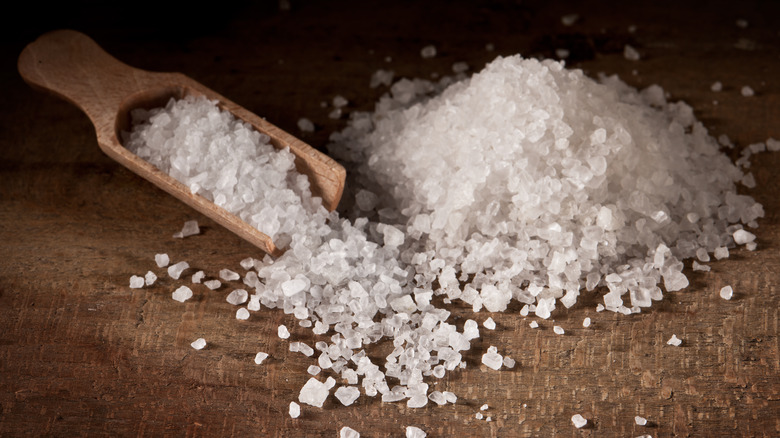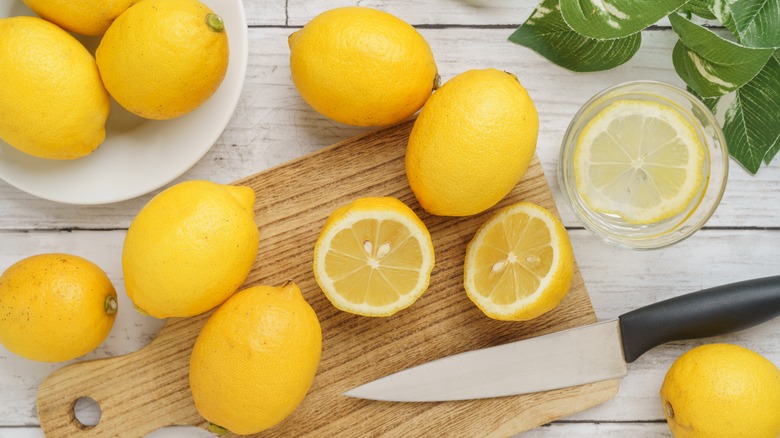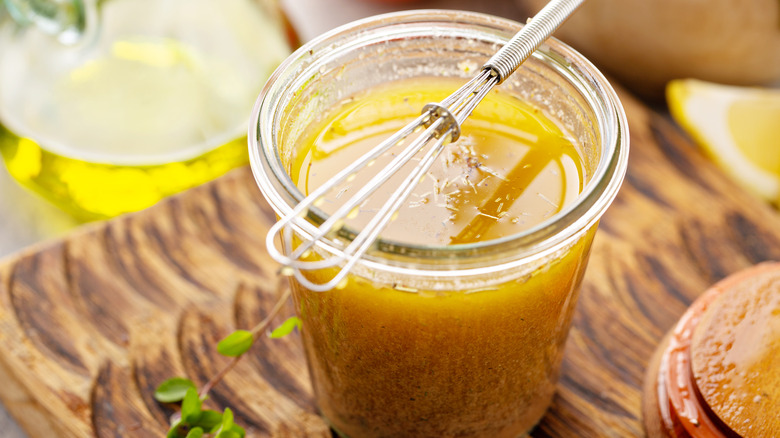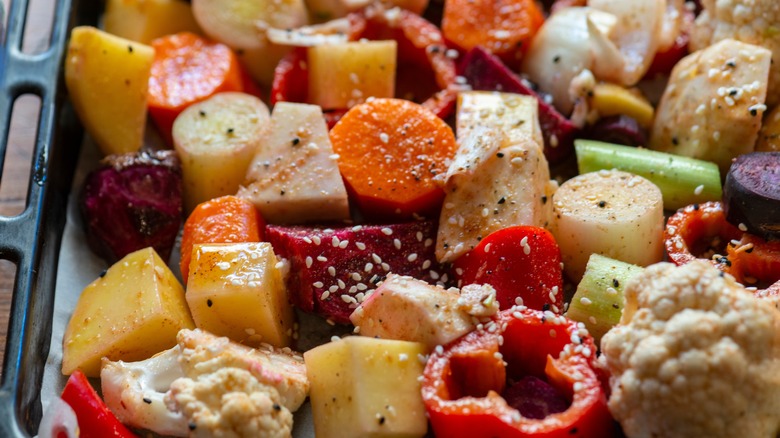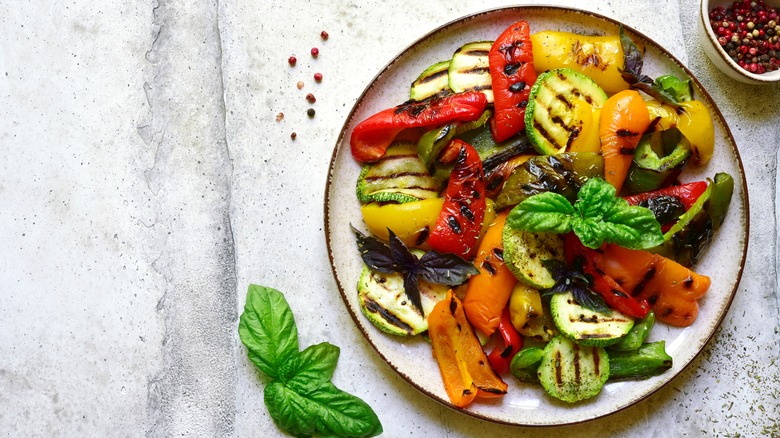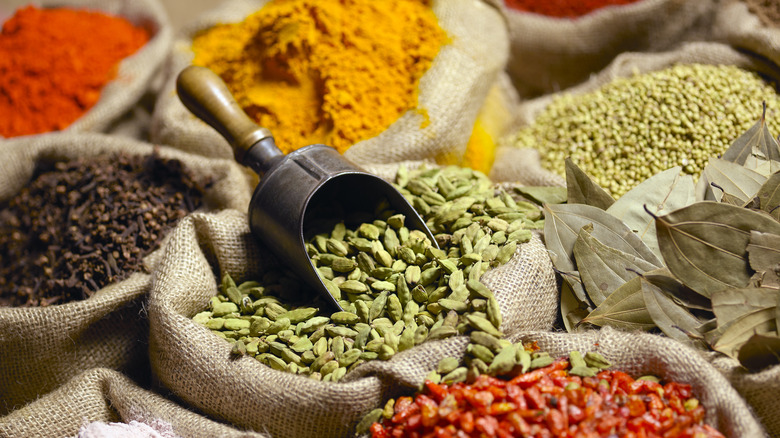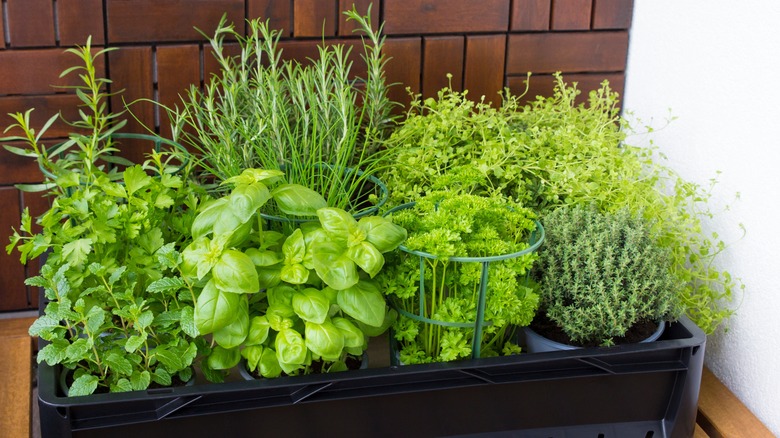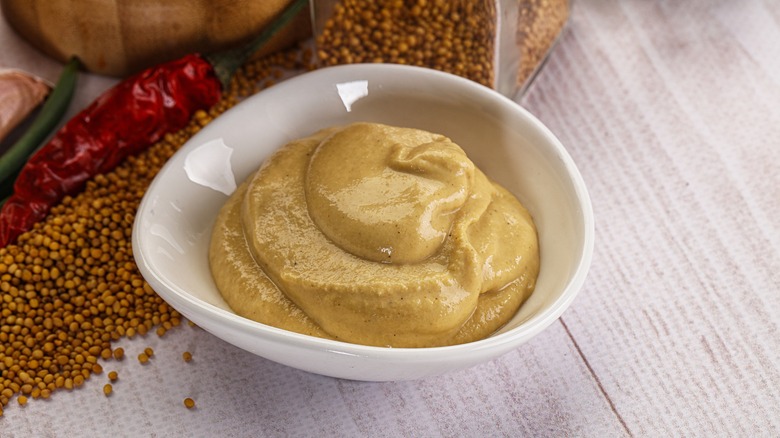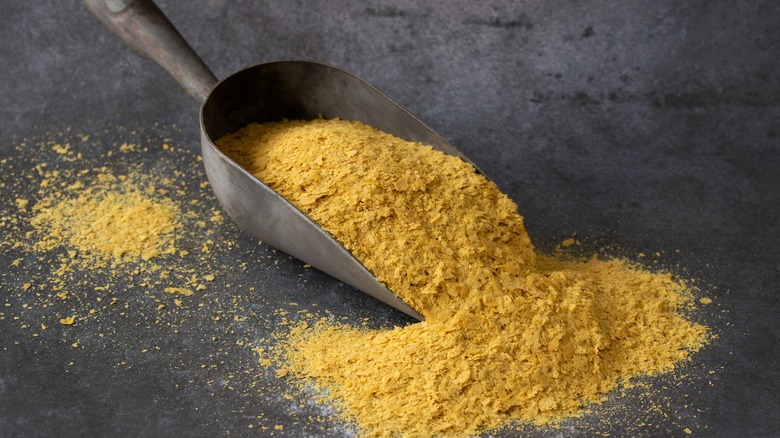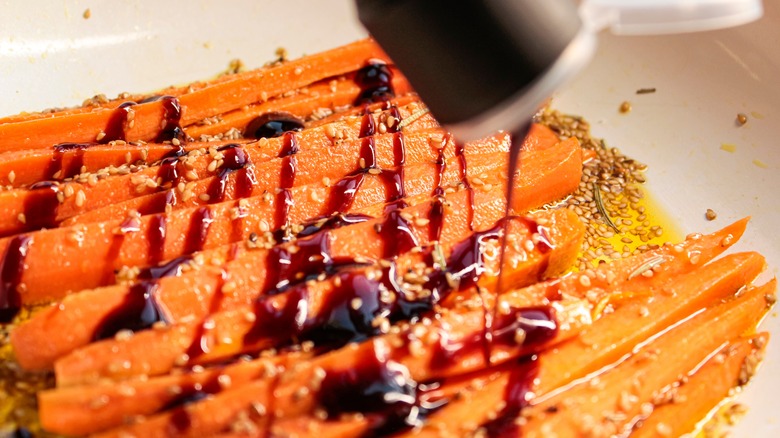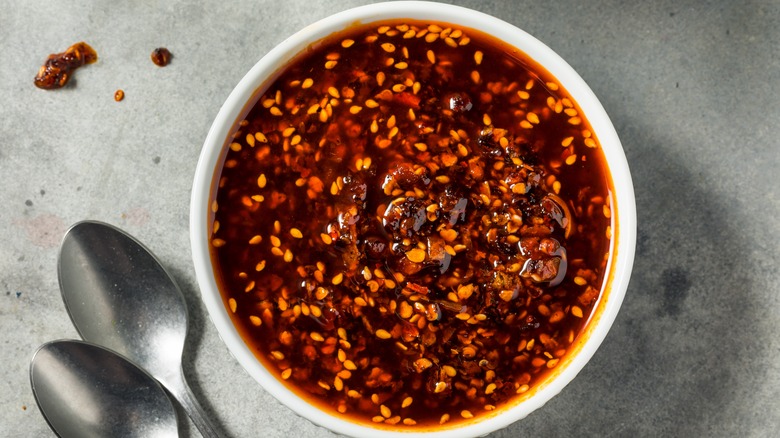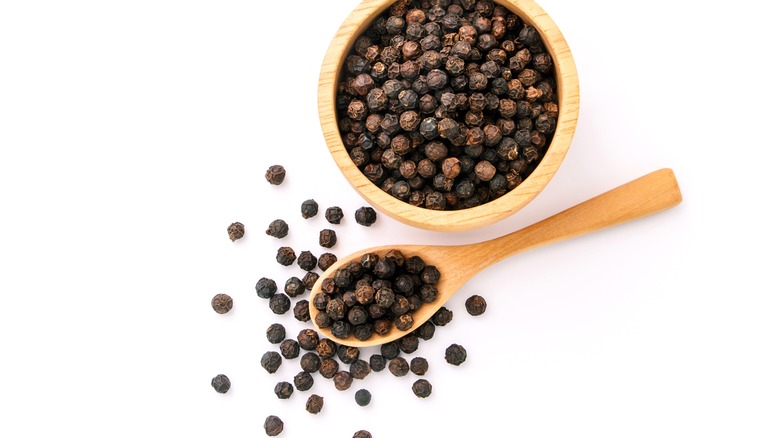13 Ways To Add More Flavor To Roasted Vegetables
It's a good idea to get more vegetables into our diet whenever we can, and having roast veggies alongside a main meal is a quick and easy way to increase our intake. However, maximizing the flavor of those vegetables can sometimes seem like too much effort, and we end up making the same old dish every week. But adding more flavor to roast veggies isn't that difficult, and the difference to the final dish can be mind-blowing.
To serve as guides through this culinary journey, I asked two chefs to share their expert advice on how to add extra flavor to roasted vegetables. Classically trained chef and plant-forward nutritionist Jackie Newgent joins Ryan Forte — the executive chef at Carolina Farm Trust — in sharing their knowledge and substantial experience to offer a few key tips for getting the most out of veggies.
From adding lemon to choosing the best herbs, let's uncover techniques that will take your roast veggies from standard to absolutely delicious. Grab your oven pan and join me in exploring the world of roasted vegetables.
Choose the correct oil
One of the first and most crucial steps in preparing your veggies for roasting is drizzling some oil over the top of them. But don't just reach for the closest bottle from the cupboard — putting some thought into the type of oil could have a big impact on the flavor of your roasted vegetables.
"I'm not skimpy with oil," says Jackie Newgent. "I rely mainly on extra-virgin olive oil! Adding sufficient oil and evenly coating the vegetables is a must for helping with caramelization and heightening richness." Olive oil is a common and delicious choice for roasting veggies, as its mild flavor won't be overpowering.
If you want to add a more unique slant to your vegetables, using a flavored oil is a "somewhat sneaky yet smart way to provide distinct flavor to roasted veggies," Newgent adds, and there are plenty of options to choose from. "Citrus, garlic, or herb olive oils are all quite versatile with roasted veggies," she explains, while suggesting chili pepper oil to add heat to roasted potatoes, sweet potatoes, green beans, and tomatoes.
Olive oil is not the only good option for roasting veggies, though. "Coconut oil will add a sweetness," says Ryan Forte. In addition to lending a unique flavor to the vegetables, coconut oil has a fairly high smoke point, meaning that you can turn the heat up on the oven without worrying that it will burn.
Don't skip the salt
You may wonder if adding salt to your veggies is really necessary, but a sprinkle of this seasoning is indeed important for flavoring your dish. "Vegetables have very, very little natural sodium, so don't forget to season them with salt — it's the key way to punch up taste," advises Jackie Newgent, who frequently adds salt both before and after roasting vegetables. Adding salt at the beginning of the cooking process can ensure that the veggies are more evenly seasoned, and offer an assist in caramelization. "By adding it at the end as well, you can make sure the taste is spot-on," she explains.
Ryan Forte agrees that adding salt before and after cooking is fine, as long as you check the taste during the process. "I always season before I cook, but there is nothing wrong with seasoning after, as you should always taste your food before you serve it," he says. "I like to use kosher salt. All brands are different. I like one that is not too coarse, but not too small either."
If salt is a major concern in terms of your health, Newgent points out that you can choose to only add salt after cooking, which will make the vegetables seem saltier than if you add it in advance. This means that you can use less of this sodium-rich seasoning, and still enjoy its flavoring benefits.
Liven up the flavors with citrus
A really straightforward way to add plenty of flavor to your roasted vegetables is to squeeze a little citrus juice over them, either before or after they cook. "Citrus is used a lot for vegetables," says Ryan Forte. "I always like to finish mine at the end."
The type of citrus you use may depend on the cuisine. For example, Jackie Newgent recommends adding "a squirt of lime juice to roasted corn or sweet potatoes in a Mexican meal, and lemon juice to roasted eggplant or potatoes in a Mediterranean meal." A little bit can add a lot of brightness — "just don't overdo it," she warns.
Though this works well in many dishes — like a lemon-roasted fennel recipe — adding citrus juice to roasted vegetables isn't the only option. Newgent suggests slicing up a variety of citrus fruits and roasting them alongside the veggies, then presenting them on top. "They'll add some sweetness, balance bitterness, [and] enhance browning during roasting," she explains.
She also recommends using fruit zest to add color and freshness to the vegetable when it has finished roasting. Just be sure to zest first, then juice, as trying to zest an already-juiced lemon is not fun. "Try lemon zest on asparagus, lime zest on carrots, and orange zest on beets," she suggests. "If you don't need all the zest, it freezes well for later use."
Marinate the vegetables
Before you cook meat, there is a good chance that you marinate it in some sort of dressing, often consisting of oil, lemon juice, and seasonings. Well, there is no reason that your veggies don't deserve the same treatment. Ryan Forte recommends this, stating that marinating the vegetables will provide a "lot of added flavor."
The great thing about creating a marinade is that you can customize it to suit whatever vegetables you are preparing. At its most basic, your marinade can include olive oil, vinegar, and garlic, which will work perfectly well, but feel free to get creative, too.
Honey, mustard, or soy sauce will all impart bold flavors to your vegetables, making them more interesting once they hit the plate. Since marinades and vinaigrettes often contain similar ingredients, you can even whip up a vinaigrette as a secret ingredient for marinating roasted vegetables, and use the same vinaigrette on an accompanying salad for a harmonious meal.
Although meat is always marinated in advance to help break down the protein, you can choose to add dressing to your veggies either before they cook or afterward. Either way, your vegetables will have a lovely depth of flavor that will upgrade them from being a typical side dish.
Be creative with your choice of vegetables
When you're leading a busy life and trying to fit healthy dinners into your evenings, it can be easy to fall into a rut of resorting to the same vegetables every time. But there are loads of delicious options out there just waiting to adorn your plate, and roasting them often brings out their best flavors.
Jackie Newgent has plenty of suggestions if you're looking for inspiration. "The list is practically endless when it comes to vegetables that are extra-tasty when roasted, but some of my favorites are peppers, Brussels sprouts, eggplant, butternut squash, baby potatoes, broccoli, and cauliflower," she says, adding that she like to throw surprises into the mix. "For instance, many people wouldn't roast cucumbers — but they're delicious when roasted and stuffed into a sandwich."
Ryan Forte also has a suggestion for an underused vegetable that will make a brilliant accompaniment to your entrées. "Fennel comes out amazing when it's roasted. The flavor really pops," he says.
Make the most of the flavor imparted by roasting
While adding flavoring ingredients to your vegetables before and after roasting is a great way to boost their taste, it is important to recognize that the roasting process itself is going to play a big role in creating a sweet and tangy veggie dish. Jackie Newgent points out that "the technique of roasting already heightens the flavor of vegetables," because the natural sugars in the veggies will caramelize as they cook in the oven, giving them a delicious sweetness by the time they're ready.
To maximize this effect, be sure to spread your vegetables out evenly on the baking tray, and don't crowd them. This will allow the edges to brown up nicely, giving you more of that sought-after caramelized flavor.
If your veggies are not quite as dark as you would like, Ryan Forte has a tip to help them along. "A nice char from the grill is always a nice touch," he says. After roasting, throw the veggies on the grill for a few minutes until you get those signature scorch marks that leave a distinctive, delicious flavor.
Add flavors that match the cuisine
The beauty of roasted vegetables is how versatile they are, and how you can transform them with different added ingredients. Jackie Newgent likes to adapt them to suit the cuisine of the whole meal, meaning that different seasonings are added each time.
"While I often enjoy keeping roasted vegetables simple — relying mainly on extra-virgin olive oil, sea salt, and the natural browning that occurs during roasting to let the vegetables be at their flavorful best — I also consider how I intend to serve them to determine if I want to flavor the vegetables differently," Newgent explains. She draws inspiration from the herbs, spices, and condiments that are common in her chosen cuisine, and adds them to her roasted veggies to allow them to enhance the rest of the meal. For example, with a Middle Eastern meal, "I may add a pinch of cinnamon, sprinkle with fresh mint or toasted pine nuts, and serve with a squirt of fresh lemon juice," she says, while noting that with Asian cuisine she may use tamari soy sauce on her vegetables.
Take time to think in advance about what ingredients will complement the flavors of your meal. This way, you can ensure that your roasted veggies enhance the rest of the food, and taste wonderfully different depending on what you are serving them with.
Use a variety of fresh and dried herbs
As any enthusiastic home cook knows, herbs are the cornerstone of a good meal. Easy to grow and requiring virtually no prep, they can lift a dish with just a sprinkling of chopped leaves. Roasted vegetables can definitely benefit from the aromatic flavors of herbs, but which ones can be used? Ryan Forte has a simple answer: "All fresh herbs can be used. I like to use fresh, but also have used dried when I'm in a pinch."
Fresh and dried herbs can be useful at various stages of the cooking process, since they have different flavor profiles. "If you want an herb or herbs to be integral to the roasted vegetables, generally use dried herbs at the beginning of the roasting process, or finish with fresh herbs — or do both," says Jackie Newgent. But this is just a guide, as there are some herbs that don't quite follow the rules. "Fresh rosemary is generally best earlier in the roasting process rather than at the end, like in rosemary roasted potatoes or other root vegetables," she adds.
Sometimes it's best not to overthink things, and Newgent advises being playful with your herbs and trying out new pairings. "I suggest tossing out any 'rules' you think exist, and uncover your own favorite combinations. For instance, dill works great with carrots, but you might personally enjoy tarragon or mint more," she says.
Coat veggies with Dijon mustard
If you are a fan of mustard, you are likely in the habit of adding a dollop to sandwiches, burgers, and meat. But have you considered how a little of this condiment could elevate your roast vegetables? Once you've tasted deliciously chargrilled veggies coated in mustard, you will wonder why it never occurred to you before.
But what type of mustard is going to take your vegetables to the next level? According to Jackie Newgent, Dijon is the best option. "If you're a Dijon mustard fan, whisk a little into extra-virgin olive oil and toss vegetables with the mixture before roasting," she recommends.
The difference in the heat of popular types of mustard comes down to what mustard seeds they are derived from. American mustard gets its mild flavor from white mustard seeds, whereas hot mustards — like the Chinese variety — have brown mustard seeds to thank for their intense heat. Dijon sits somewhere in the middle, as it's made from a mixture of black and brown mustard seeds, giving it a kick of intensity that will be perfect for your roasted veggies.
Of course, if you're feeling brave you can always coat veggies in Chinese mustard before roasting them. But be warned — the vegetables will definitely be hot!
Up the umami with nutritional yeast
One of the great things about roasted veggies is that they allow you to have a completely plant-based meal, packed with nutrition and flavor. But what if you are craving some cheesy goodness to boost the flavor, while keeping everything vegan? Jackie Newgent has the answer: nutritional yeast. "For that Parmesan cheese-like kick, you can simply sprinkle some of these flakes onto roasted vegetables right when they come out of the oven," she suggests. "It keeps the vegetables plant-based, while providing a bit of vitamin B12 and protein."
If you have never tried nutritional yeast before, add it to your shopping list immediately. It is a wonderful replacement for cheese that offers plenty of health benefits, including potentially reducing the chances of heart disease and boosting immunity. Growing in popularity in recent years as more people move toward a plant-based diet, nutritional yeast is yeast that has been deactivated to stop it from fermenting. It can be sprinkled on top of any food in the same way that Parmesan can, and will impart a similar umami-rich flavor.
Add a vinegar glaze
To up the flavor of your roasted vegetables with a sharp tang, consider adding a vinegar glaze. Ryan Forte is a fan of flavoring veggies this way, adding it after they come out of the oven. "I like to finish mine with vinegar sometimes, and let that finish and glaze over the vegetables," he says.
Balsamic vinegar is a popular option for glazing vegetables, as its sweet and sour notes complement the caramelized veggies perfectly, such as in a balsamic roasted Brussels sprouts recipe. Though you can buy balsamic glaze at the grocery store, making your own is always going to taste better, especially if you use good-quality vinegar. Look for the term "aceto balsamico tradizionale" on the label, as this means it has been made with traditional techniques.
If you choose an aged balsamic with a thick, syrup-like texture, you can simply drizzle the vinegar over the veggies when they are done roasting. Alternatively, you may want to make a vinaigrette by adding olive oil and mustard to the balsamic, then coating the vegetables in the mixture. Whichever method you choose, adding a vinegar glaze to your roasted vegetables will give them a delicious tang, and create a sophisticated side dish that everyone will enjoy.
Add chili crisp
If you feel that your side dishes are lacking spice, then upgrade roasted vegetables with chili crisp. If you haven't tried chili crisp before, do your taste buds a favor and make some immediately. As a Chinese condiment that has been used for centuries, chili crisp is becoming a popular seasoning in the West, topping all sorts of dishes from pasta to sandwiches.
Made from dried chili flakes and oil, along with flavorings like garlic and soy sauce, chili crisp is an umami-filled assault on the senses, and your roasted vegetables will benefit hugely from its addition. If you are wary about adding too much heat, scale back on the chili flakes and add more garlic instead. A pinch of sugar is often added to balance the delicious savory flavors, so you can add more if you prefer your chili sauces on the sweet side.
Roasting veggies with chili crisp creates a fabulously tasty side dish that can be served alongside any type of entrée to liven up the flavor. The contrast of the spicy sauce with the sweet vegetables, along with the veggies' crispy texture, will enhance your dish and leave your dinner companions wanting more.
Add black pepper
Adding black pepper to roasted vegetables is something you have probably done before. However, choosing the right cooking stage when you add it is crucial to getting the best flavor, and preventing the pepper from being scorched.
"I don't regularly add black pepper to roasted vegetables," says Jackie Newgent. "But when I do, I do so with intent — and at the end of cooking, so the pepper doesn't burn when using a high roasting temperature, and so you see and smell all the freshly cracked peppercorns at serving."
There is a good reason to add some freshly ground black pepper to your dishes, other than simply the flavor of the spice itself. Black pepper helps you to taste the food that it's sprinkled on, meaning the subtle flavors of the caramelized veggies will be enhanced by the presence of pepper.
This effect is at its strongest when the peppercorns' interiors are freshly exposed, so crushing your own peppercorns rather than relying on the pre-ground stuff is crucial. Take Newgent's advice and add a twist of freshly ground pepper to the veggies just as you are serving them up, allowing everyone to enjoy the delicious aromatic scent and flavor.
